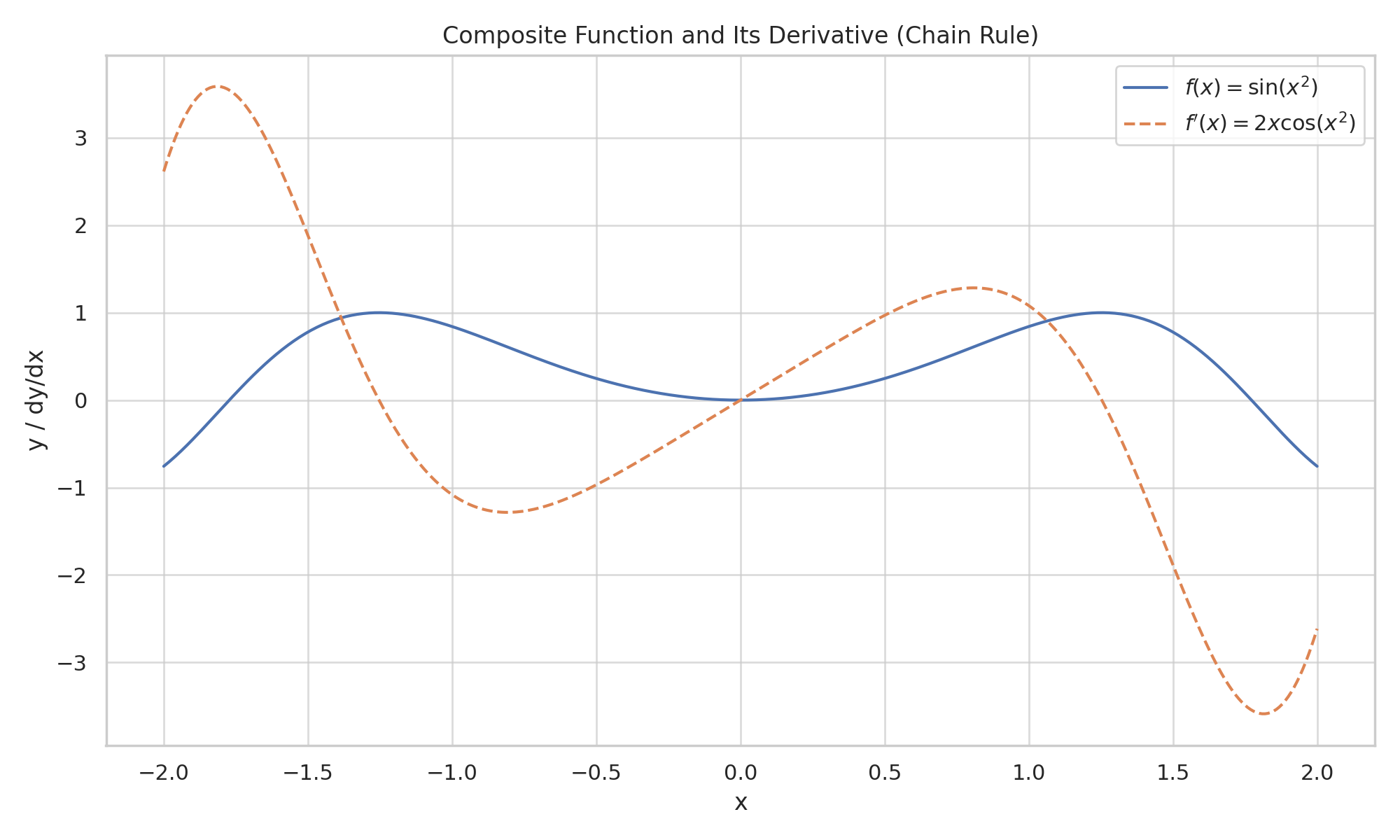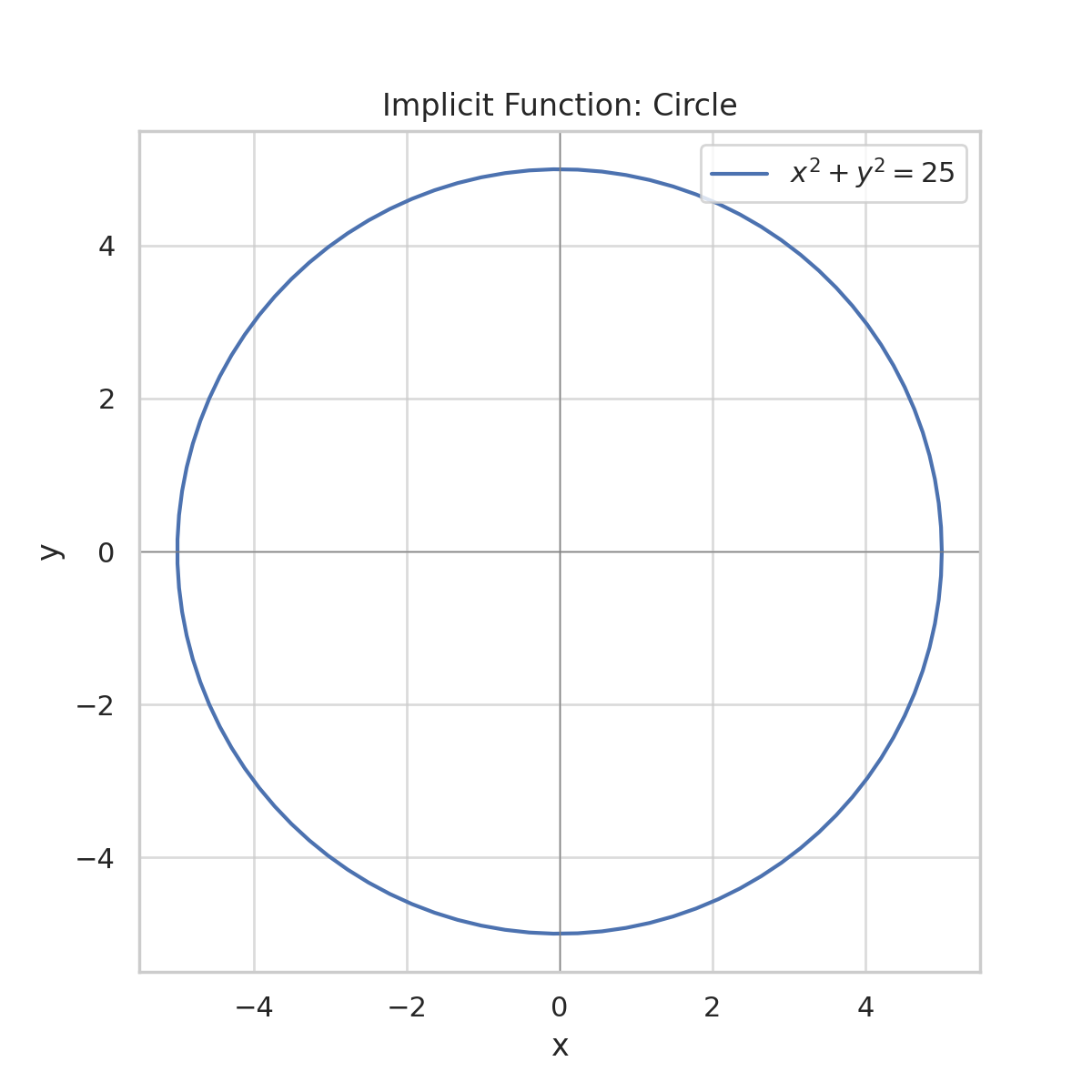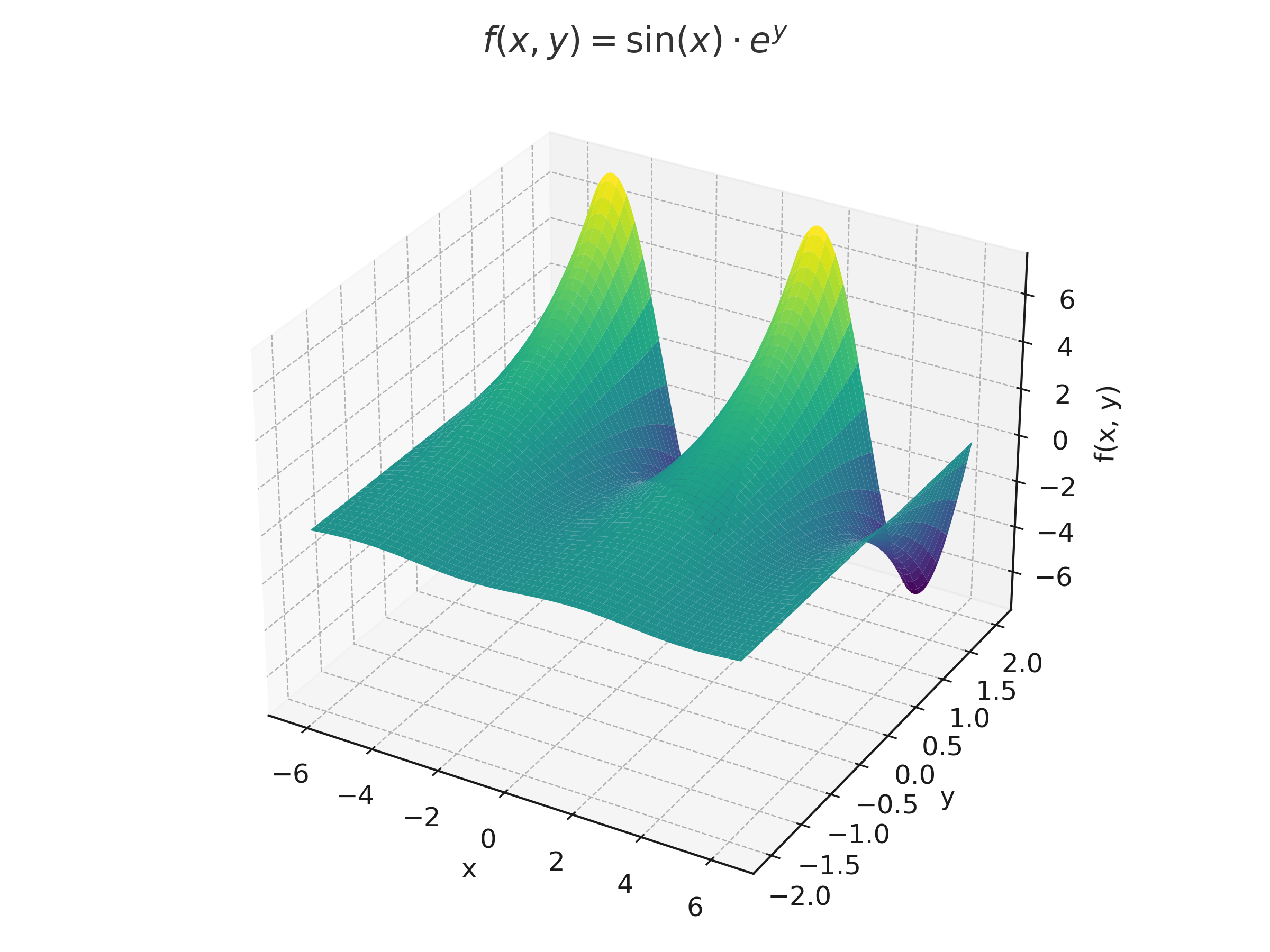🔗 Chain Rule, Implicit Differentiation, and Partial Derivatives (Calculus for ML)
Understand the Chain Rule, Implicit Differentiation, and Partial Derivatives with simple examples. Learn how to differentiate composite and multivariable functions step by step — a must for machine learning.
Before diving into neural networks or complex optimization, it’s critical to master three powerful tools in calculus: the Chain Rule, Implicit Differentiation, and Partial Derivatives.
In this post, you’ll learn:
- How to apply the chain rule to composite functions
- How implicit differentiation builds on the chain rule
- How to differentiate multivariable functions with respect to one variable (partial differentiation)
📚 This post is part of the "Intro to Calculus" series
🔙 Previously: Understanding Gradients and Partial Derivatives (Multivariable Calculus for Machine Learning)
🔜 Next: Understanding the Jacobian – A Beginner’s Guide with 2D & 3D Examples
🔗 What is the Chain Rule?
The chain rule allows us to differentiate composite functions, i.e., functions inside other functions.
Let’s say:
\[ f(x) = h(p(x)) = \sin(x^2) \]
We treat the outer function \( h(u) = \sin(u) \), and the inner \( p(x) = x^2 \).
Using the chain rule:
\[ f’(x) = h’(p(x)) \cdot p’(x) = \cos(x^2) \cdot 2x \]
✅ So, the derivative of \( \sin(x^2) \) is \( 2x \cdot \cos(x^2) \)
🧮 Python: Symbolic Chain Rule
1
2
3
4
5
6
import sympy as sp
x = sp.symbols('x')
f = sp.sin(x**2)
dfdx = sp.diff(f, x)
dfdx = 2*x*cos(x**2)
🧠 Another Chain Rule Example (Step-by-Step)
Let’s find the derivative of:
\[ f(x) = \ln(3x^2 + 1) \]
This function has a function inside a function, which is exactly when we use the chain rule.
🔹 Step 1: Identify the Inner and Outer Functions
We rewrite the function as:
\[ f(x) = h(p(x)) \]
Where:
- The inner function is: \( p(x) = 3x^2 + 1 \)
- The outer function is: \( h(u) = \ln(u) \), with \( u = p(x) \)
🔹 Step 2: Differentiate Each Part
- \( h’(u) = \frac{1}{u} \) → this is the derivative of \( \ln(u) \)
- \( p’(x) = \frac{d}{dx}(3x^2 + 1) = 6x \)
Now apply the chain rule:
\[ f’(x) = h’(p(x)) \cdot p’(x) = \frac{1}{3x^2 + 1} \cdot 6x \]
✅ Final Answer
\[ f’(x) = \frac{6x}{3x^2 + 1} \]
💡 Why This Matters
When differentiating logarithmic, trigonometric, or exponential functions wrapped around polynomials, the chain rule is your go-to tool. You treat the “outside” and “inside” layers separately, then multiply the results.
🔁 Implicit Differentiation
Sometimes, functions are not written in the form \( y = f(x) \). Instead, x and y are mixed together in one equation. In that case, we can’t isolate y easily — so we use implicit differentiation.
📘 Example: A Circle
Take the equation of a circle:
\[ x^2 + y^2 = 25 \]
This defines a relationship between x and y, but y is not explicitly solved.
🧠 Step 1: Differentiate both sides with respect to x
Apply \( \frac{d}{dx} \) to each term:
\[ \frac{d}{dx}(x^2) + \frac{d}{dx}(y^2) = \frac{d}{dx}(25) \]
- \( \frac{d}{dx}(x^2) = 2x \)
- \( \frac{d}{dx}(25) = 0 \) (constants have zero slope)
- \( \frac{d}{dx}(y^2) = 2y \cdot \frac{dy}{dx} \) ← this uses the chain rule, because y is treated as a function of x
So the full result becomes:
\[ 2x + 2y \cdot \frac{dy}{dx} = 0 \]
✍️ Step 2: Solve for \( \frac{dy}{dx} \)
Subtract \( 2x \) from both sides:
\[ 2y \cdot \frac{dy}{dx} = -2x \]
Divide both sides by \( 2y \):
\[ \frac{dy}{dx} = \frac{-x}{y} \]
💡 Interpretation:
Even though we didn’t solve for y directly, we found the slope of the curve at any point (x, y) on the circle. This is powerful — we differentiated without rearranging!
🔗 This method is essential when:
- y appears in powers or multiplied with x
- You have to find \( \frac{dy}{dx} \) but can’t isolate y
- You’re working with geometric shapes, constraint equations, or system-level models in ML
🔀 Partial Derivatives
When a function depends on more than one variable (e.g., \( f(x, y, z) \)), we can differentiate with respect to one, treating the others as constants.
Let:
\[ f(x, y, z) = \sin(x) \cdot e^{yz^2} \]
🔹 Differentiate with respect to \( x \):
Only \( \sin(x) \) is affected:
\[ \frac{\partial f}{\partial x} = \cos(x) \cdot e^{yz^2} \]
✅ Here, \( y \) and \( z \) are treated as constants.
🔹 Differentiate with respect to ( y ):
\[ \frac{\partial f}{\partial y} = \sin(x) \cdot e^{yz^2} \cdot z^2 \]
Chain rule applied to the exponent!
🔹 Differentiate with respect to \( z \):
\[ \frac{\partial f}{\partial z} = \sin(x) \cdot e^{yz^2} \cdot 2yz \]
🧮 Python: Symbolic Partial Derivatives
1
2
3
4
5
6
7
8
9
10
11
import sympy as sp
x, y, z = sp.symbols('x y z')
f = sp.sin(x) * sp.exp(y * z**2)
df_dx = sp.diff(f, x)
df_dy = sp.diff(f, y)
df_dz = sp.diff(f, z)
df_dx, df_dy, df_dz
Output:
1
2
3
4
(exp(y*z**2)*cos(x),
z**2*exp(y*z**2)*sin(x),
2*y*z*exp(y*z**2)*sin(x))
This confirms our analytical work.
✅ 3. Visualizing f(x, y) = sin(x) · e^y in 3D
📊 Python: 3D Surface Plot
1
2
3
4
5
6
7
8
9
10
11
12
13
14
15
import numpy as np
import matplotlib.pyplot as plt
X, Y = np.meshgrid(np.linspace(-2*np.pi, 2*np.pi, 100), np.linspace(-2, 2, 100))
Z = np.sin(X) * np.exp(Y)
fig = plt.figure(figsize=(8, 6))
ax = fig.add_subplot(111, projection='3d')
ax.plot_surface(X, Y, Z, cmap='viridis')
ax.set_title(r'$f(x, y) = \sin(x) \cdot e^y$')
ax.set_xlabel('x')
ax.set_ylabel('y')
ax.set_zlabel('f(x, y)')
plt.show()
🤖 Relevance to Machine Learning
Understanding these differentiation tools is essential for anyone working in machine learning:
- 🧮 Chain Rule powers backpropagation in neural networks. Each layer’s gradient is computed by chaining derivatives through the layers — exactly as taught by the chain rule.
- ⚙️ Partial Derivatives form the backbone of gradient-based optimization. In functions with multiple variables (e.g., model weights), we compute partials to know how each parameter affects the loss.
- ❓ Implicit Differentiation appears in constrained optimization and in tools like Lagrange Multipliers, often used when variables can’t be expressed directly.
- 📉 These techniques together allow models to learn, update weights, and minimize error during training.
In short: these aren’t just abstract math tricks — they’re the mathematical gears that drive intelligent systems.
🚀 Level Up
- 💡 The Chain Rule extends naturally to multiple nested layers — this is the foundation of backpropagation in neural networks.
- 🔁 Implicit Differentiation is especially useful in constraint optimization problems where you can’t isolate a variable.
- 🌐 Partial Derivatives are essential for working with functions of many variables — you'll see them in gradient vectors, Jacobians, and Hessians.
- 📊 In machine learning, partial derivatives guide how each weight is updated during training.
- 🧠 Want to go deeper? Explore the Total Derivative and Directional Derivatives for full control over multivariate calculus.
✅ Best Practices
- 🔍 Break down complex expressions into inner and outer layers to apply the chain rule step by step.
- 🧠 Label your inner and outer functions clearly — this reduces mistakes and makes your process transparent.
- 📐 Use implicit differentiation when a function defines x and y together — especially useful for constraint problems.
- 🧮 In partial differentiation, freeze all variables you're not differentiating with respect to — treat them like constants.
- 📊 Simplify before and after differentiating — it helps reduce errors and makes the final expression cleaner.
- 📈 Check your results visually when possible using a graphing tool to confirm slope behavior matches intuition.
⚠️ Common Pitfalls
- ❌ Forgetting to multiply by the derivative of the inner function when using the chain rule — the #1 mistake!
- ❌ Applying the power rule directly to composite expressions without unpacking layers first.
- ❌ Misusing implicit differentiation by forgetting to apply the chain rule to y terms.
- ❌ In partial differentiation, accidentally differentiating with respect to more than one variable at once.
- ❌ Confusing constant functions with constant coefficients — constants like 7 are different from terms like 7x.
📌 Try It Yourself
Test your understanding with these practice problems. Each one focuses on a key technique: chain rule, implicit differentiation, or partial derivatives.
📊 Chain Rule: What is \( \frac{d}{dx} \sin(5x^2) \) ?
This is a composite function: \( \sin(u) \) where \( u = 5x^2 \)🧠 Step-by-step: - Outer: \( \frac{d}{du} \sin(u) = \cos(u) \) - Inner: \( \frac{d}{dx}(5x^2) = 10x \) ### ✅ Final Answer: \[ \frac{d}{dx} \\sin(5x^2) = \\cos(5x^2) \\cdot 10x \]
📊 Implicit Differentiation: Given \( x^2 + xy + y^2 = 7 \), find \( \frac{dy}{dx} \)
Differentiate both sides with respect to \( x \):🧠 Step-by-step: - \( \frac{d}{dx}(x^2) = 2x \) - \( \frac{d}{dx}(xy) = x \cdot \frac{dy}{dx} + y \) ← product rule! - \( \frac{d}{dx}(y^2) = 2y \cdot \frac{dy}{dx} \) - \( \frac{d}{dx}(7) = 0 \) Putting it together: \[ 2x + x \cdot \frac{dy}{dx} + y + 2y \cdot \frac{dy}{dx} = 0 \] Group \( \frac{dy}{dx} \) terms: \[ (x + 2y)\frac{dy}{dx} = -(2x + y) \] ### ✅ Final Answer: \[ \frac{dy}{dx} = \frac{-(2x + y)}{x + 2y} \]
🔁 Summary: What You Learned
| 🧠 Concept | 📌 Description |
|---|---|
| Chain Rule | Differentiates composite functions by chaining outer and inner derivatives. |
| Implicit Differentiation | Differentiates equations where y is not isolated, using the chain rule on y terms. |
| Partial Derivative | Differentiates multivariable functions with respect to one variable at a time. |
| Backpropagation | Uses chain rule to compute gradients layer by layer in neural networks. |
| Gradient Vector | A vector of partial derivatives used in optimization and ML training. |
| Derivative of sin(x²) | \( \frac{d}{dx}\sin(x^2) = 2x \cdot \cos(x^2) \) |
| ∂f/∂x of f(x, y, z) | \( \frac{\partial}{\partial x}(\sin(x)e^{yz^2}) = \cos(x)e^{yz^2} \) |
💬 Got a question or suggestion?
Leave a comment below — I’d love to hear your thoughts or help if something was unclear.
🧭 Next Up
Now that you’ve learned how to compute partial derivatives, you’re ready to tackle the next building block in multivariable calculus: the Jacobian Matrix.
In the next post, we’ll explore:
- What the Jacobian is and how it’s constructed
- Why it’s essential for transformations, coordinate changes, and machine learning gradients
- Step-by-step examples for both scalar and vector-valued functions
Stay curious — you’re one layer closer to mastering the math behind modern ML models.


